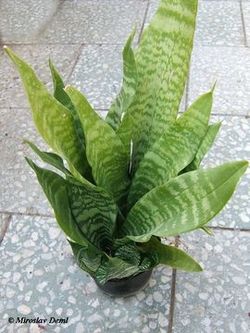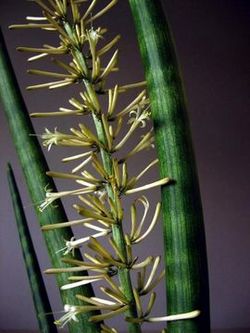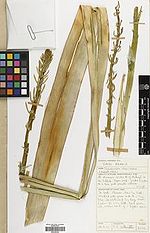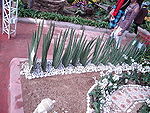Sansevieria
| Sansevieria |
|---|

|
| Scientific Classification |
|
| Species |
|
| The Flower Of Sansevieria |
Sansevieria is a taxonomic genus of succulents also known as the mother-in-law's tongue, devil's tongue, jinn's tongue, bow string hemp, snake plant and snake tongue. The name of sansevieria was originated by Raimondo Di sangro who was the prince of Italy.[3]
Body Design
The sansevieria is a perennial plant and its roots are short and thick. The leaf is thin and long. Sometimes, there are roots that are similar to snakeskin.[4] It also has the poison, so we cannot eat it. There are various shapes of each species.[5]. When you try to dry it, you should dry it in the shade. Never dry it in the sunlight after cutting the leaf.[6]There are many shapes in each species.
Life Cycle
It is usually ousted as a white fiber because its leaves are tough and elastic. It is strong from dry environs and it is thermophiles. It can be cultivated in the winter. The breeding occurs in between June and September by such as multiplication of a plant by separating the roots. [7]. There are many methods of breeding: leaf-cutting, planting on the sand, water, or subterranean stem, and multiplication of a plant by separating the roots.
Leaf-cutting: There are two methods of leap-cutting. One is the planting on the sand. Another is the planting on the water. If the leaf is planted the wrong way, It will be fail. When you try to dry it, you should dry it from the shade. never to dry it from the sunlight after cutting the leaf. The speed of rooting is different in environs. when sansevieria is in warm, it will grow quickly, but in opposite, it will grow slowly. In this method (leaf-cutting), there is no chimera.
Planting on the sand: It has the advantage that the rate of success is higher than the planting on the water, and the growing leaf is more healthy, and has the disadvantage that the speed of rooting is so slow. Cut the leaf between 5~10cm and dry it in the shade for 3~4 days, then plant in the sand. The temperature should be kept between 20~30℃ and watered after planting on the sand. When you water to this plant, it is better to use bottom watering. It is almost rooted in 1~2 months.
Planting on the water: The speed of rooting is faster than sand, but the rate of success is worse. Cut the leaf between 5~10cm and dry it from the shade for 7~10 days, then plant in the water. The temperature should be kept between 20~30℃. You should change the water every 2~7 days. It will root in 20~40 days.
Multiplication of a plant by separating the roots: Separate from mother after sprouting. You should care of it so carefully, and separate it from the root of mother, and plant, then water after 10~15 days.
Planting on the subterranean stem: This is the method that is cutting the leaf about 5cm. This doesn't become known, and is not clear. [8]
Cultivation
The sansevieria is poisonous and therefore, it is inedible. But It surpass air clean and release a anion. It grows in the high temperature and humidity well.[9]For the fertilization, The established plants can be useful. We can test the soil that determine existing nutrient levels in the soil. In the house, we can fertilize by there methods: The water-soluble and quick release fertilizers, temperature controlled slow-release fertilizers, and organic fertilizers. Underestimating the light needs of houseplants that require full sun shouldn't be accepted. Because Sansevieria is tropicals. It should be on the place where is within 2 feet of a southern exposure window, or at the very minimum, a room that stays bright. The ample water is necessary material for houseplant. Water it until the soil is saturated and then drains freely from the holes in the bottom of pot. Finally, the Spider Mites, Mealybugs are dangerous to the sansevieria. Therefore, we should take care of it carefully.[10]
Effectiveness
The sansevieria surpasses air clean and release a anion. The the National Aeronautics and Space Administration (NASA) have studied for purification the air of hermetically sealed spaceship in space, and They found the sansevieria's skill and certify. Environmental scientists at NASA, studying methods for biological purification of space station air, have discovered that several common houseplants reduce amounts of formaldehyde, benzene, carbon monoxide, and nitrous oxide in the air by absorbing these harmful gases through their leaves. Also This plant let the inside's humidity keep 60%, so It let us don't need humidifier. In summer, it let the degree down about 2~3℃, and opposite, let it up about 2~3℃ in winter.[11]
Video
Cultivation of Sansevieria
References
- Sansevieria. USDA. Web. accessed May.5.2012. Unknown Author
- Sansevieria. Wikispecies. Web. Accessed May.5.2012 Unknown Author.
- 산세베리아(Sansevieria). tongaria. Web. Accessed July.28.2011 Unknown Author.
- bowstring hemp,Sansevieria. "doopedia" Web. accessed May.5.2012. Unknown Author
- 산세베리아 키우기, 산세베리아 효능. "지식정보채널". Web. Accessed june.10.2011. Name is nickname, 와글.
- Sansevieria trifasciata( Snake Plant ). "backyardgardener.com". Web. Unknown accessed date and Author.



